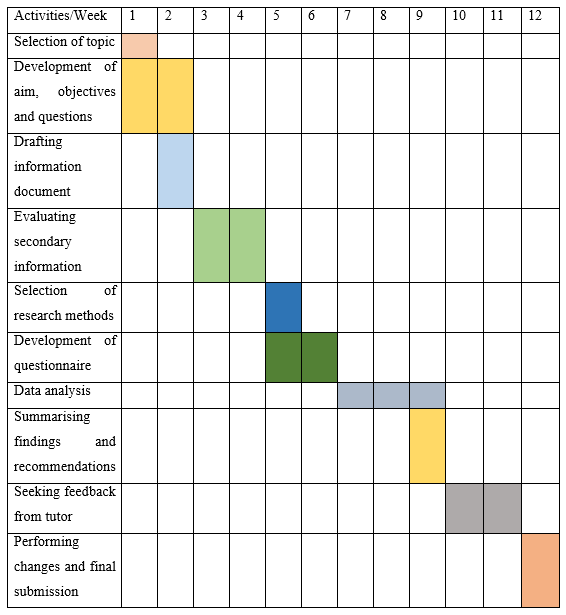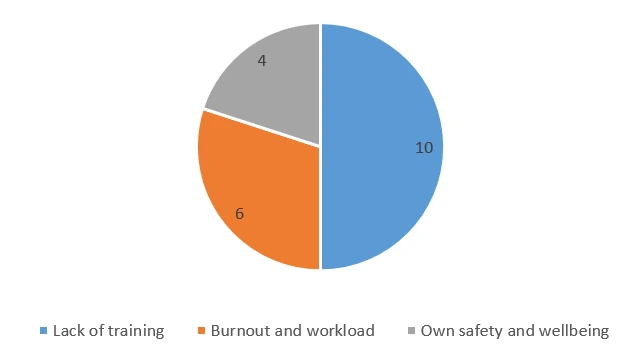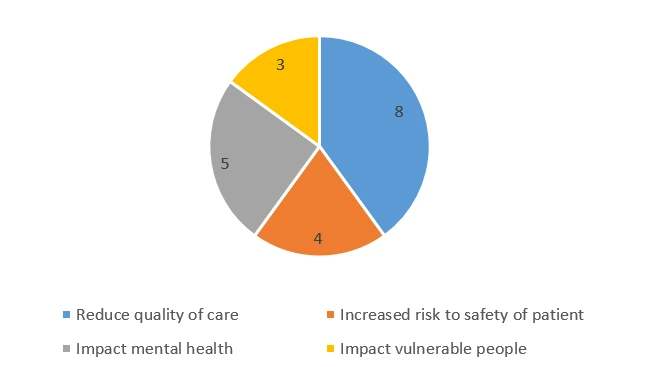+44 75754 30035 help@rapidassignmenthelp.co.uk
offer
🎁Special Offer 🎁 Discounts - Up to 55% OFF!
🎁Special Offer 🎁 Discounts - Up to 55% OFF!
The Impact of Healthcare Worker Shortage on NHS Birmingham Service Quality Case Study examines the complex health and social care system within the UK, focusing on how staff shortages affect service delivery and quality. Health and social care workers provide crucial support across treatment and rehabilitation phases. This assignment help UK explores the factors contributing to workforce shortages and their implications for NHS Birmingham, employing qualitative and quantitative analysis for in-depth understanding.
Health and social care is complex system of activities, policies along with relationship within different healthcare and social environment, stressing on geographical aspects of treatment and care delivery and provision (McFadden et al, 2021). A health and social care workers and practitioners provides health support to the people from initial care to rehabilitation. The current research study aims to analyse the impact of the shortage of the staff on the service delivery and quality within the UK health and social care field. The study will use relevant research methods to collect and analyse the information and to gain the in-depth knowledge about topic.
The aim of the research is to analyse the influence of shortage of healthcare workers on the quality and delivery of service in the National Health Service (NHS) Birmingham.
Maintaining privacy and confidentiality while conducting research is one of the most crucial factor to complete study successfully. Researcher has complied with ethics, values, principles and policies to avoid any legal complications. While collecting primary data by survey, researcher has maintained the privacy and confidentiality to prevent the participant’s data from misuse. Additionally, no harm to any person has been created who were involved in the research. Proper referencing was done by researcher and credit has been also given to the authors.
This study reviews existing research highlighting causes of staff shortages such as an aging population, burnout, uneven workforce distribution, and insufficient training. It also considers organizational management challenges and pandemic-related impacts, connecting these to the decline in service quality and increased workload stress among NHS staff.
Theme 1: Factors which increase the shortage of healthcare workers in healthcare industry
According to, Poon et al, (2022) healthcare industry is highly responsible sector and healthcare workers provide treatment, care and support to the patients. From recent years, healthcare industry is facing staff shortage issues. There are different factors that are responsible for increasing workers shortage issue. It involves an aging population, burnout and stress, uneven distribution of workers and lack of training. As mentioned by, Winter, Schreyögg and Thiel (2020) however, healthcare organisations are also liable for staff shortage. The organisation have poor management strategies that increase the burden on the doctors, nurses and other workers. It is stated by, Kumari et al, (2020) the Covid-19 has worsened the healthcare staff shortage through increasing demand and needs for medical services. Because of increasing stress and concerns regarding own safety, nurses are leaving the healthcare industry. Furthermore, rural regions usually struggle to attract new workers or retain old healthcare professionals because of lack of resources and low salaries.
Theme 2: Impacts of staff shortage on quality and service delivery in healthcare organisation
In accordance with, Nelson et al, (2022) staff shortage issues highly affect the delivery as well as quality of the health care services. When hospitals have insufficient staff then they are not able to provide the services immediately to the patients. It reduces the trust of the patients towards the hospitals. As stated by, Leong et al, (2021) staff shortage problem also increases the workload for existing workforce and they have to work extra hours. It can reduce the quality of care which can further impact the patient’s health. Workers have to perform multiple duties due to lack of staff and it reduce performance and productivity. According to, Asefa et al, (2022) staff shortage impact the treatment process which can lead to longer waiting times and patients could not get treatment on time. For example, NHS Birmingham is facing high level of staff shortage which harm the performance of the organisation. Approximately 100,000 job vacancies were vacant across health service in year 2019 (Birmingham Live, 2019).
Theme 3: Different challenges faced by the healthcare professionals while offering services
It is mentioned by, Liu et al, (2020) Healthcare professionals want to provide effective services but they face several challenges during duty which prevent them to give proper care. Growing use of technology create problems for workers because they have not sufficient knowledge about technical tools. From the point of view of, Razu et al, (2021) healthcare differences and biases are a considerable challenge experiencing by doctors, nurses and general practitioners. There are lot of patients that do not have access to quality care. It is essential for workers to identify the ways to solve disparities so that they can give treatment to underserved communities. In accordance with, Nyashanu, Pfende and Ekpenyong (2020) upholding a positive work culture in the hospitals is essential yet challenging. Workers have to work in complex situations and for long hours but poorly organised workplace can negatively impact the morale of workers. Due to this issues, they could not concentrate on their work and face problems.
Q.1 What are the different factors that raise the problem of staff shortage in healthcare industry?
Q 2. What are the various impacts that affect the care service quality and delivery due to staff shortage?
Q 3. What are the different challenges experienced by workers while offering healthcare services?
The project employs mixed research methodologies—inductive and deductive approaches, qualitative and quantitative types, and exploratory and descriptive designs. Data is gathered through surveys and secondary sources, with thematic and statistical analysis techniques to interpret findings from a sample of NHS Birmingham healthcare workers.

Research approach: Inductive and deductive are two kinds of research designs used by the researchers. Inductive approach refers to the method of creating theories on the basis of observations or data. Deductive research approach is described as process in which an analyst starts with generalisation or theory and after that tests it by data collection. Inductive research approach has been implemented by the researchers as it provide chance to modify ways according to data they collect.
Research type: There are majorly two types of research such as; qualitative and quantitative. Qualitative research refers to the study of nature of phenomena and is particularly suitable for responding questions of why (Lê and Schmid, 2022). Quantitative research is a kind if objective technique and collects a numeric data. Qualitative has been applied by the researcher as it allowed to ask questions which cannot be put into numerical value to know human experiences.
Research design: Research design has two mainly two categories which are exploratory and descriptive. Exploratory design analyses research topic in deep manner and evaluate those contexts that has not been analysed in past. While, descriptive design gathers data and information regarding specific group. Exploratory research design has been utilised by researcher to because it is concerned with outlining deep and greater understand about topic.
Data collection: Primary data collection refers to the process where an analysts gather first-hand information by conducting survey or interview. Secondary data collection is the method of gathering data that are already published by someone. A researcher conducted a survey to collect primary data and use text books and online websites for secondary information.
Sampling plan: Probability sampling is explained as method where samples chosen from larger population according to probability theory. In non-probability sampling, an analyst chooses sample which is based on judgement (Vaughn and Jacquez, 2020). Probability sampling has been utilised to choose sample size. 20 healthcare workers of NHS Birmingham have been selected randomly.
Data analysis: There are two techniques by which collected data could be measured and those are thematic and statistical. Thematic analysis is a method utilised to find out repeated patterns or themes in data. Statistical technique is relevant for evaluating numerical information. Researcher has utilised thematic analysis to improve authenticity of evaluation.
| Q 1. How often do you face staff shortage in your department? | Frequency |
| Rarely | 3 |
| Often | 8 |
| Always | 9 |
| Total | 20 |

| Q. 2 In your opinion, what is the major factor behind staff shortage? | Frequency |
| Lack of training | 10 |
| Burnout and workload | 6 |
| Own safety and wellbeing | 4 |
| Total | 20 |

| Q. 3 Does current staff problem impact your performance? | Frequency |
| Yes | 16 |
| No | 4 |
| Total | 20 |

| Q. 4 How staff shortage impact the patients? | Frequency |
| Reduce quality of care | 8 |
| Increased risk to safety of patient | 4 |
| Impact mental health | 5 |
| Impact vulnerable people | 3 |
| Total | 20 |

| Q. 5 According to you, what is the best way to address worker shortage issue? | Frequency |
| Recruit additional | 9 |
| Increase training efforts | 6 |
| Focus on work environment | 5 |
| Total | 20 |

Using surveys and thematic analysis, the research reveals high prevalence of staff shortages, with reported impacts on worker performance, patient care quality, and mental health risks. Respondents recommend increasing staff hiring, enhancing training, and improving work conditions to address these challenges effectively.
Interpretation 1: A survey has conducted on nurses which helped to know that most of the staff members felt that staff shortage is biggest issues. 9 out of 20 participants accepted that they faced high level of staff shortage in their department. While 8 respondents said that they often experienced this situation and 3 workers admitted they rarely staff shortage.
Interpretation 2: Participants were asked about major factors behind staff shortage. Most of people approximately 10 accepted lack of training is major factor. Whereas; 6 and 4 participants said burnout and workload and own wellbeing are liable for issue.
Interpretation 3: It has analysed that shortage of staff highly impact the performance of other workers. Because 16 respondents said yes and only 4 workers said that staff shortage issue does not affect their performance.
Interpretation 4: Members were asked about impact worker shortage in patients. 8 and 4 people said that it has reduced care quality and maximised risk of patient safety. Out of 20, 5 and 3 respondents admitted that it affect mental health and vulnerable individuals.
Interpretation 5: In a survey, participants were also asked about the best method to address issue. 9 out of 20 means majority of people said an organization should hire more staff. 6 and 5 workers said they should maximise training efforts and build work environment.
From this research, I came to know about various factors which increased the shortage of workers within healthcare sector. I used different academic text books and websites to gain in-depth knowledge about research topic. I identified that NHS Birmingham which is a largest healthcare organisation in UK is facing high level of staff shortage.
Get assistance from our PROFESSIONAL ASSIGNMENT WRITERS to receive 100% assured AI-free and high-quality documents on time, ensuring an A+ grade in all subjects.
Recommendations regarding research area
From research about the topic related to shortage of workers in health and social care organisation, it has identified that it needs more research. The current study analysed the impact of the healthcare workers shortage on quality and service delivery in the healthcare industry of UK. The findings revealed a different factors that are responsible for growing staff shortage issue. Taking into consideration the research findings, the researcher should involve more people in primary research so that researcher would perform more effective research.
The current research has explained about the different factors behind shortage of staff. These findings will definitely help the healthcare organisations to improve their own strategies to manage the workers. By using this information, management of hospitals and clinics will try to reduce the burnout and stress faced by the doctors and nurses. The organisation will understand the significance of training and organise training programs to increase worker’s engagement in their work.
Conclusion
The research has explained that burnout, stress, workload, lack of growth opportunity, lack of training and own wellbeing is some factors behind the worker’s shortage issue. It has analysed that because of staff shortage, existing healthcare workers are facing many problems and could not be able to provide quality care. Relevant research methodologies like inductive, exploratory, qualitative, thematic analysis along with primary research have been utilised which helped to perform research efficiently.
References
Books and Journals
Online
Introduction: Real-Life Case Study-Individual Report (CW1) Get free samples written by our Top-Notch subject experts for...View and Download
Supply Chain Awareness and Key Logistics Challenges The Supply chain and logistic is essential for corporation to run the daily...View and Download
Introduction This case of Thatchers Cider Company Limited v Aldi Stores Limited (2024) brings intricate issues of trademark law...View and Download
1.0 Introduction - AHS205 The Australian Healthcare System AHS205 The Australian Healthcare System within a Global Context...View and Download
Introduction to the case study Get free samples written by our Top-Notch subject experts for taking online Assignment...View and Download
EV Awareness Program in Kanjaba: Achieving Net Zero Carbon Emissions The Towards Net Zero Carbon Emission for the Imaginary...View and Download
